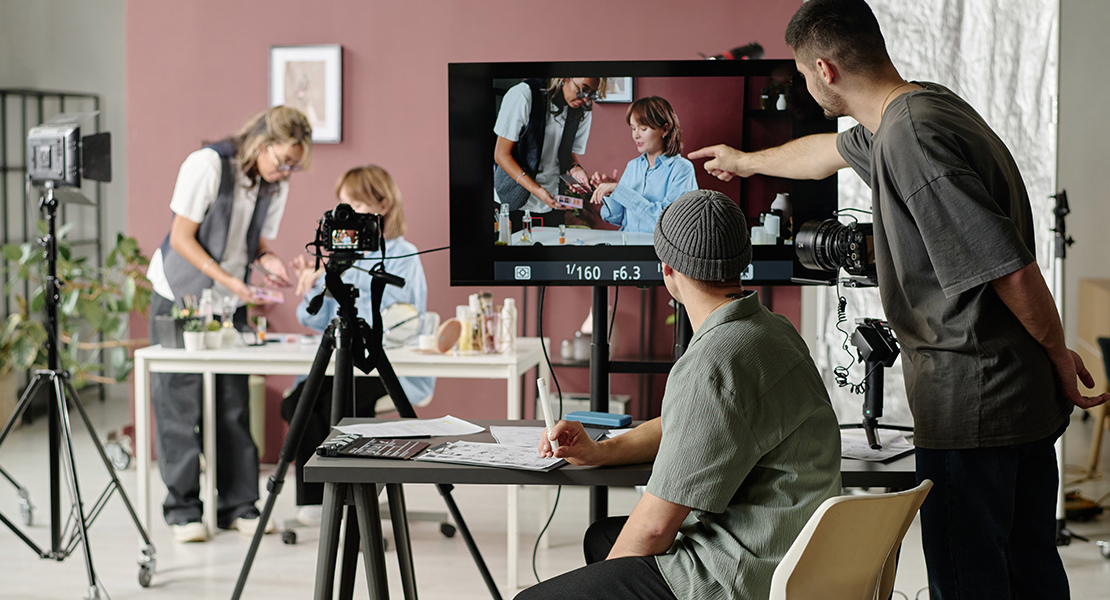
Introduction: Why Your Training Videos Deserve Better
Let’s be honest—most training videos are a bit of a slog. You’ve probably sat through a few yourself: endless slides, monotone voiceovers, and a feeling that you’re ticking boxes rather than actually learning anything useful. The problem? Too many training videos are built for compliance, not engagement. They’re created to prove that training happened, not to make sure the message landed. But here’s the thing—employees are smart, time-poor, and constantly bombarded with information. If your content doesn’t grab them, it won’t stick. And that means wasted time, wasted resources, and missed opportunities to actually improve performance.
But it doesn’t have to be that way.
Training videos can be powerful. When done right, they’re one of the most effective ways to share knowledge, boost confidence, and build a stronger team culture. They can be clear, concise, and even entertaining. Yes, entertaining. People want to learn—they just don’t want to be bored while doing it.
This guide is here to change the way you think about employee training. It’s not about flashy production or massive budgets. It’s about making smart choices that keep people interested and help them retain what matters. Whether you’re creating a quick explainer or a full training series, these 15 practical tips will help you craft videos that people actually want to watch—videos that inform, inspire, and get results.
Because at the end of the day, effective training isn’t about ticking a box. It’s about making a difference.
1. Know Your Audience Inside Out
Before you even think about hitting record, take a step back and really understand who you’re talking to. Are your employees tech-savvy? Do they prefer informal communication or something more polished? The more you know about them—their pain points, goals, and daily routines—the easier it is to create content that resonates. Training shouldn’t feel like a lecture from the headmaster; it should feel like a conversation with a colleague. So ditch the jargon and formalities. Use language they actually use at work. And if possible, involve a few team members in the planning stage—get their input on what they’d find helpful or interesting. When you design with empathy and relevance in mind, people are far more likely to engage with the video, not just zone out. It’s about making them feel seen, not preached at. That’s where real engagement begins.
2. Start With a Bang, Not a Yawn

First impressions count, and the start of your training video is your big chance to grab attention. If it kicks off with ten seconds of your company logo spinning slowly, you’ve already lost them. Jump straight into something punchy—a surprising stat, a quick anecdote, or even a cheeky bit of humour. Set the tone early on and show them why this video matters to them. Frame the problem you’re solving right away: “Ever wondered why our customer feedback is dipping?” or “Tired of feeling lost during project handovers?” That hooks people in. Think about your opener like the first line of a good story. It should spark curiosity or deliver instant value. If they’re not intrigued within the first 20 seconds, you’re toast. Respect their time and attention, and they’ll reward you with genuine interest.
3. Keep It Short and Snappy
Let’s be honest—no one is sitting at their desk hoping for a 45-minute training session. Attention spans are short, and time is tight, so break your content into bite-sized chunks. Each video should cover one key idea and do it well. Think five to seven minutes max. Any longer, and you risk wandering into lecture territory. If you’ve got a lot to say, make it a series. People are more likely to finish a playlist of five-minute videos than slog through one monolithic beast. Short videos also make it easier to revisit specific sections when they need a refresher. It’s about respect: respect for their workload, their time, and their brains’ capacity to absorb information. So cut the fluff, trim the tangents, and stick to what matters. Your goal isn’t to say everything—it’s to say the right things clearly and concisely.
4. Make It Visually Interesting
We’ve all seen the dreaded slideshow-turned-video. Flat slides, monotone narration, and zero energy. If you want employees to stay awake, let alone engaged, visuals matter. Use dynamic transitions, text overlays, animations, and real footage to bring your content to life. Don’t be afraid to use humour or bold graphics if that fits your brand. Even stock footage can be powerful when used smartly. Think visually—what can you show instead of just saying? Demonstrating a task on screen is always better than describing it in words. And please, no walls of text. Break up information with bullet points, icons, or even quick quizzes. Visual storytelling doesn’t mean being flashy for the sake of it—it’s about reinforcing the message in a way that’s easy on the eye and the brain. Boring visuals kill interest faster than bad scripts ever could.
5. Use Real People, Not Just Narrators

People connect with people. So if your training video only features a disembodied voice over slides, you’re missing a trick. Put real faces on screen—employees, managers, or even customers when appropriate. There’s something about seeing someone speak directly to camera that builds trust and relatability. It makes the message feel authentic, not scripted. Use team members where you can—they bring credibility and familiarity. It’s also great for internal culture. Hearing a peer explain how they use a system day-to-day is far more effective than a polished actor reading lines. Of course, you’ll want to ensure they’re comfortable and clear on camera, but authenticity beats perfection every time. When people see someone like them sharing knowledge, they’re far more likely to listen, learn, and apply it.
6. Tell a Story, Don’t Just Share Facts
Facts are fine—but stories stick. If you want employees to actually remember what you’re teaching, wrap it in a narrative. Instead of listing safety protocols, show a scenario where someone avoids an accident because they followed procedure. Instead of explaining a sales technique, tell the story of a rep who nailed a deal using it. Stories create emotional engagement, which leads to better recall and more buy-in. People tune out of lectures, but they lean into stories—they want to know what happens next. And the good news is, your workplace is full of stories waiting to be told: customer wins, problem-solving moments, lessons learned. Use them. Make your training human and relatable. A strong story gives context to the content and helps the message land. So next time you’re planning a training video, ask yourself: what’s the story behind this?
7. Inject Personality Into Your Script
Forget the stiff, corporate-speak. If your script sounds like it was written by a robot, employees will tune out before you even get to the good bits. Write like you talk—naturally, clearly, and with a bit of personality. Use contractions (“you’ll” instead of “you will”), rhetorical questions, and everyday phrases. Don’t be afraid to show some humour or quirkiness if it fits your culture. Your goal isn’t to sound like an instruction manual—it’s to sound like a helpful colleague. Read your script out loud before recording. If it feels awkward or unnatural, rewrite it. A conversational tone keeps things approachable and digestible. Remember, people learn best when they feel relaxed and open, not when they’re bracing themselves for corporate jargon. So keep it light, keep it real, and above all, keep it human.
8. Make It Interactive Where You Can

Want to turn passive viewers into active learners? Then make your training videos interactive. It doesn’t have to be complicated. Simple things like on-screen quizzes, clickable sections, or even a “what would you do?” decision moment can make a massive difference. Interactivity encourages people to engage with the material, not just watch it. It also boosts retention—when viewers have to think or act, they’re more likely to remember. Some platforms allow you to build these features in directly, but even if you’re using basic tools, you can prompt interaction by pausing for reflection or encouraging note-taking. For example, “Pause the video now and list three takeaways you’d apply today.” It’s about turning the learning process into a two-way street. When employees feel involved, they stop being passive consumers—and start becoming active participants.
9. Match the Pace to the Topic
Pacing is everything. Go too fast, and viewers feel overwhelmed. Go too slow, and they get bored. The trick is to find a rhythm that suits the complexity of your topic—and the experience level of your audience. If you’re covering something basic, move quickly and keep the energy up. But if the subject is technical or new to most people, slow down, give space for the information to land, and don’t be afraid to repeat key points. Vary your tone and speed to keep it interesting. Break longer explanations with visual aids or mini-recaps. Ask yourself: does this need a full explainer, or would a quick demo do? Pacing isn’t just about speaking speed—it’s about how you structure your content so it’s easy to follow, no matter the viewer’s starting point.
10. Use Real-World Scenarios
If your training video feels too abstract, it won’t stick. People need to see how the information applies to their actual work. That’s why real-world scenarios are so powerful. Use situations your employees face day-to-day to illustrate key points. Show what good (and bad) looks like. Walk through a typical customer interaction, a workflow, or a crisis moment. When people see themselves in the content, they pay attention. It validates their experience and helps them connect the dots between training and action. Scenarios also make content more memorable—”Remember that video where the manager handled the upset client?” is much easier to recall than “Remember the list of customer service tips?” So ground your training in reality. The more it reflects their world, the more useful—and watchable—it becomes.
11. Break the Monotony With Variety
No one wants to sit through a video that feels like one long, unchanging scene. Keep things lively by mixing up your format. Use a blend of live-action footage, screen recordings, animation, talking heads, and even interviews. You can also vary the locations—don’t feel tied to the same office backdrop. A change in scenery, tone, or visual style helps reset attention and keeps viewers alert. Think of your video like a good conversation—it should have energy and movement. Even something as simple as switching from full-screen to a split view, or throwing in a quick infographic, can refresh the viewer’s focus. Just make sure the variety supports the message and doesn’t distract from it. The goal is to keep people engaged, not overwhelmed. When you use visual diversity with purpose, your videos become not only more professional—but far more enjoyable to watch.
12. Reinforce With Recaps and Callbacks
Repetition doesn’t have to be boring—it can be a powerful learning tool when used right. At the end of each section or video, do a quick recap of the key takeaways. This helps reinforce the message and gives people a moment to mentally process what they’ve just watched. Callbacks to earlier points can also strengthen understanding and show how the content ties together. For example, “Remember in the first video when we talked about clear communication? Here’s how that plays out in a team meeting.” It builds continuity and helps create a cohesive learning journey, rather than a set of disconnected chunks. Recaps are also useful for people who might revisit specific parts of the training later on. You’re not just repeating yourself—you’re embedding knowledge. And when employees retain more, they apply more. That’s the whole point, isn’t it?
13. Include a Clear Next Step

Every training video should end with purpose. Once the viewer finishes, what do you want them to do next? Whether it’s filling out a form, completing a task, taking a quiz, or simply reflecting on what they’ve learnt—it needs to be clear. A strong call to action not only drives behaviour but also gives the video a sense of closure and direction. It’s easy to forget this step, especially when the focus is on delivering content. But without a next step, your video risks being just another “watch and forget” exercise. Be direct and practical. Say something like, “Try this out in your next client meeting,” or “Download the checklist and apply it to your next project.” It shows that learning isn’t just theoretical—it’s actionable. And that shift from passive viewing to active doing is where the real value lies.
14. Make It Easy to Access and Revisit
Even the best training video is useless if no one can find it when they need it. Make sure your videos are housed in an easy-to-navigate platform or learning hub. They should be searchable by topic, role, or task—not buried deep in an inbox or a forgotten intranet folder. And don’t just think about first-time views—make it easy for people to dip back in when they need a refresher. Add timestamps, summaries, and tags so employees can jump straight to the section they want. The easier it is to access and revisit your content, the more likely it is to be used regularly. That’s how training becomes embedded—not just a one-off event, but an ongoing support tool. Think convenience. Think longevity. Your goal isn’t just to create a good video—it’s to create a resource that actually gets used.
15. Listen, Improve, Repeat
Last but not least—ask for feedback. Training videos should never be a “set it and forget it” project. Once your video’s out in the world, find out what people really think. Was it helpful? Engaging? Too long? Not detailed enough? Encourage honest input through surveys, casual chats, or comments on the platform itself. Then act on what you learn. Maybe your next batch needs to be shorter, or feature more team members, or use clearer examples. Treat video training like any other part of your company’s growth—it should evolve based on real-world feedback. The more you involve your employees in shaping the content, the more invested they’ll be in watching it. Improvement is a cycle, not a box to tick. So stay curious, stay open, and keep making videos people actually want to watch.

Conclusion: Make It Count, Not Just Compliant
Training
videos shouldn’t feel like a box-ticking exercise—and they don’t have to. When
you focus on making content that’s useful, relevant, and genuinely engaging,
you do more than just deliver information. You empower people. You show respect
for their time and attention. And you create a learning culture where growth
actually happens.
The tips we’ve covered here aren’t about adding more complexity or expense.
They’re about making smarter choices. Knowing your audience, telling stories,
keeping things short, using visuals, showing real people—these are all
practical, doable changes that can take your videos from forgettable to
impactful. And remember, it’s not about perfection. It’s about connection. If
people feel like the video speaks to them and helps them in their day-to-day
work, they’re far more likely to watch it, remember it, and apply it.
So next time you plan a training video, don’t just ask, “What do we need to cover?” Ask, “How do we make this something people actually want to watch?” That mindset shift makes all the difference. Because when training feels valuable, people don’t resist it—they embrace it.
You’ve got the tools, now go make something that informs, inspires, and sticks. Your team—and your business—will be better for it. And if you’d like help creating great training videos for your business, feel free to contact us at Spiel for a free consultation.

